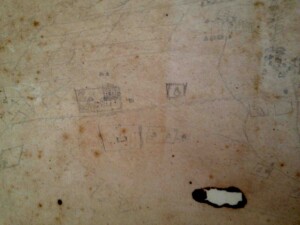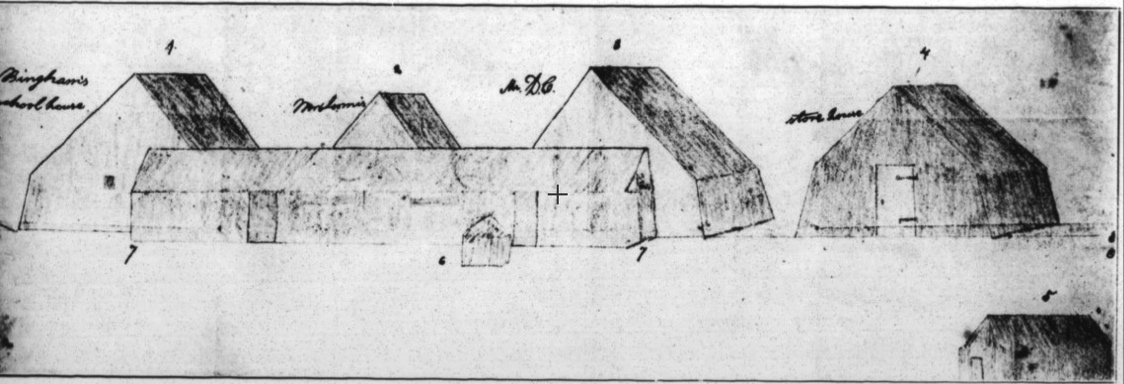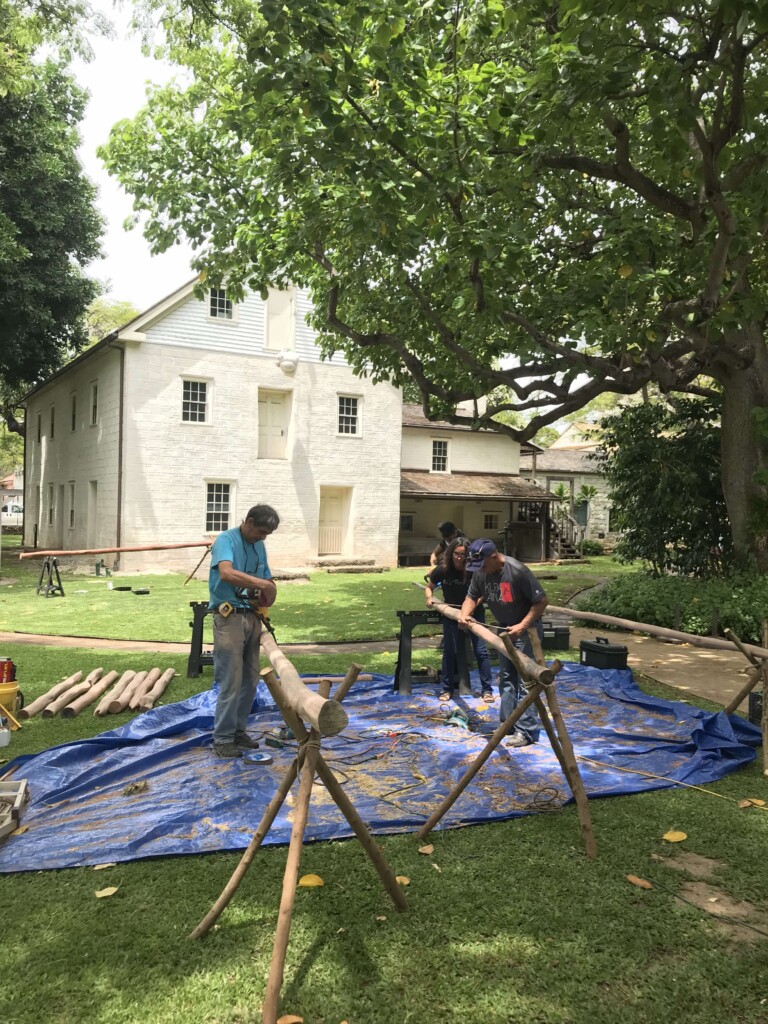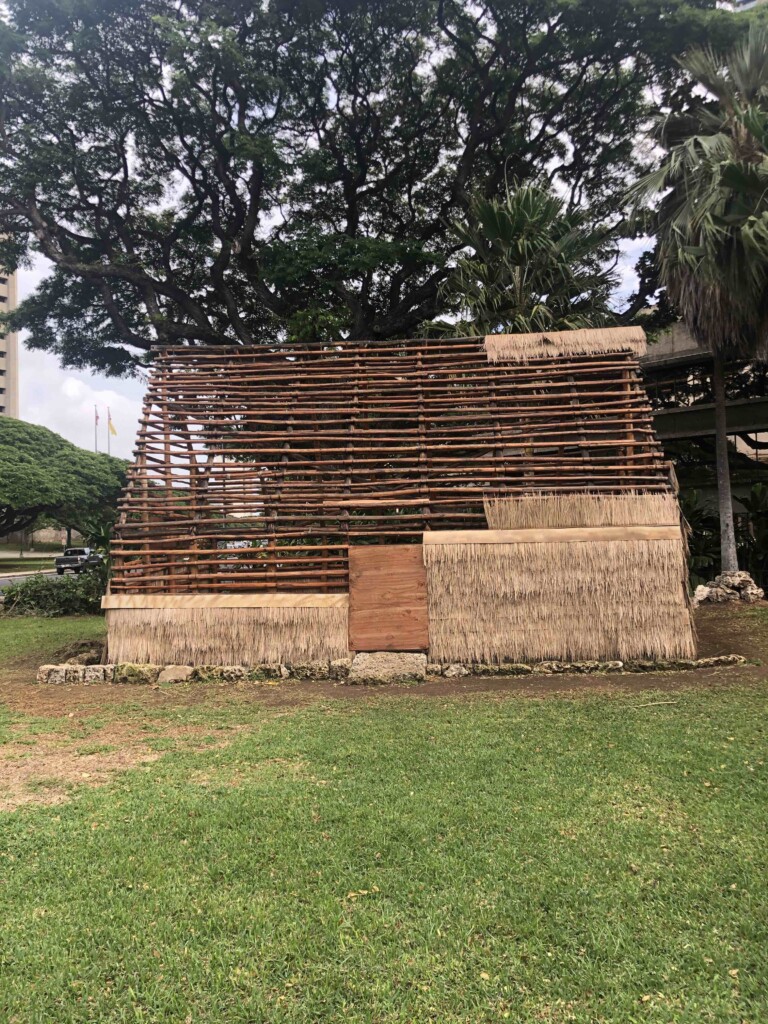The Hawaiian Mission Houses Historic Site and Archives, Kumu Earl Kawa‘a, Kumu Dwight Kauahikaua, and other stakeholders will be recognized with a Preservation Programmatic Award for the construction of a hale pili representation on the grounds of Hawaiian Mission Houses.
In 1820, by order of Liholiho, Boki, Governor of O‘ahu, had a row of hale pili (grass houses) constructed for the second company of missionaries who arrived in April of that year. The hale, occupied first by Hiram Bingham, Daniel Chamberlain with his wife and five children, and Maria Loomis and child, were situated east of the ship landing, along an uninhabited section of the road to Waikīkī that later became known as Missionary Row.
Development, research and permitting phases of the project began in 2014 under the leadership of Spencer Leineweber, FAIA, and Executive Director Emeritus Tom Woods. Kawa‘a and Kauahikaua served as cultural consultants and hale building experts. Groundbreaking for the building was held in 2018 and the final phase of thatching the hale pili will be completed this year.
 Design of the hale is based on descriptions found in the journals and letters of William and Clarissa Richards, Charles and Harriet Stewart, and Betsey Stockton from the Mission Houses’ archival collection. The dimensions primarily follow the Richards’ description.
Design of the hale is based on descriptions found in the journals and letters of William and Clarissa Richards, Charles and Harriet Stewart, and Betsey Stockton from the Mission Houses’ archival collection. The dimensions primarily follow the Richards’ description.
In order to ensure the durability of this reproduction and both the safety of it and adjoining structures, noted Peter Young, former president of Hawaiian Mission Houses, “an integration of traditional (‘ōhi‘a) and modern materials (such as artificial pili grass) and techniques were used to build the hale.”
Kawa‘a and Kumu Dwight Kauahikaua provided another dimension to the project by developing a cultural place-based curriculum to mentor students of Roosevelt High School and Kinai ‘Ehā, a nonprofit vocational training program, in traditional building methods. Students received a unique opportunity to experience contextual Hawaiian language learning and hands-on training.
Adds Young, “The programmatic effort demonstrates ways in which traditional buildings can be reinterpreted and adapted to the contemporary era and traditional knowledge passed to new generations.”
For Kawa‘a, you could say this project culminates a lifetime of learning and is a natural passing of knowledge from one generation to the next. He shared his personal thoughts on how he became involved in hale building:
“I have an abundance of basic cultural ‘ike (knowledge} and skills on many subjects and topics, growing up at a time and place where sustainability was a daily practice of doing, not a concept that requires an explanation or demonstration or a story to make the point. My foundation years were spent on the family kalo farm on Moloka‘i. You learned by listening to adults, watching and trying to do when given the opportunity…
I attended church with my family and there were lots of old people, arguing and debating over scriptures. Although wanting to engage, I refrained and listened. I continue to be involved and around kupuna in my thirties. With command of the language, kupuna in Hawaiian communities courted and were delighted to have me in their group. Kawaiaha‘o Church was my congregation of worship where I taught Hawaiian Language Sunday School classes to the kupuna, at least that’s what I told myself. Akiona, Akaka, Panui, Wakinekona, Inaina, Lopez, Hale, Linkee, Meali‘ikalama, Mahu‘iki and others were my inspiration, and fountain of information and good will. They adored me and believe all young Hawaiians should be like me. I learned so much from them and they poured information freely…
Much of the work I do, or called to do, is often in uncharted waters with great challenges and unknown outcomes. In me are the teachings of my mother and father, faith, and always put akua first. And with that I can do anything.”
- Dwight Kauahikaua and Earl Kawa’a teaching how to process the logs into hale beams, May 2018
- Kinai ‘Eha students learning to lay the rock wall around the hale perimeter, July 2019
- Hale thatching progress as of February 2020
By Beth Iwata, Director of Development
Historic Hawai‘i Foundation invites you to attend the 46th Annual Preservation Honor Awards Virtual Program on Wednesday, July 22nd from 5:00 – 6:00 p.m. The program will be streamed live via Zoom and YouTube Live and is free and open to the public; please register at the event web-page, https://historichawaii.org/awards-2020-2/





